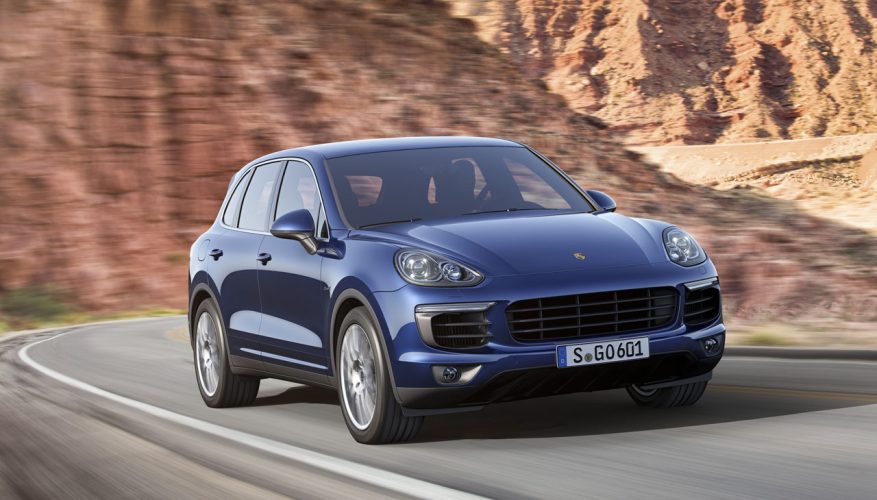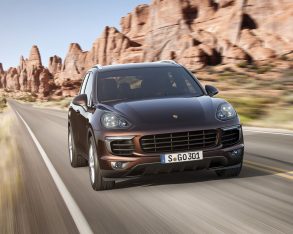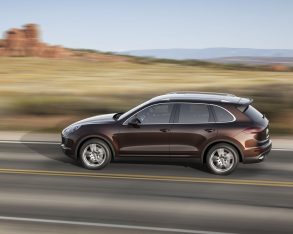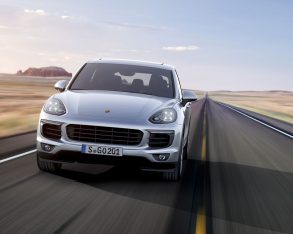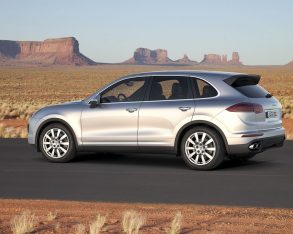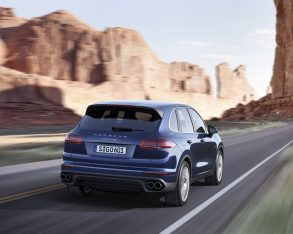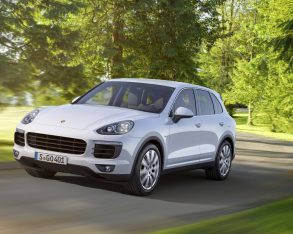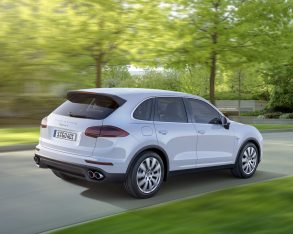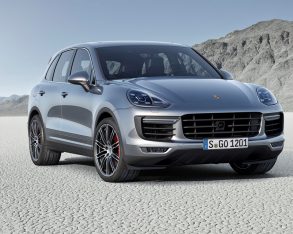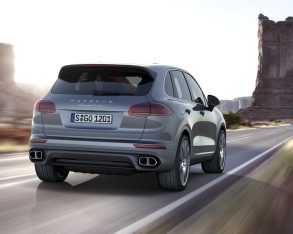 |
| For 2015, Porsche replaces its Cayenne S Hybrid with a new plug-in version dubbed Cayenne S E-Hybrid. (Photo: Porsche) |
Of course, these last problems haven’t affected the premium sector quite as harshly, where all types of luxury utes are selling very well. On that note Porsche has enjoyed tremendous success with its mid-size Cayenne, having sold nearly 580,000 examples since it debuted in 2002 (more than 276,000 first-generation models were produced between 2002 and 2010, and about 303,000 units of the second-gen model since 2010), and now 12 years later will introduce yet another spin on its spicy SUV theme.
For model year 2015, along with the entry-level Cayenne Diesel, mid-grade Cayenne S and top-line Cayenne Turbo, the Stuttgart, Germany-based brand will add a new plug-in hybrid model dubbed Cayenne S E-Hybrid, making Porsche the first
 |
| The 2015 Porsche Cayenne S E-Hybrid is the first PHEV within its segment. (Photo: Porsche) |
As you might have already guessed, the Cayenne S E-Hybrid borrows its powertrain from the Panamera S E-Hybrid already in production, a model that incidentally gets a $3,000 price drop for 2015, soon to retail for $110,000, which is the result of “synergistic effects realized by Porsche in the area of hybrid technology and ultimately passed down to the customer.” The Cayenne S E-Hybrid’s power unit combines a 333-horsepower supercharged 3.0-litre V6 with a 95-horsepower electric motor for a maximum of 416 horsepower at 5,500 rpm and total system
 |
| Porsche loses its naturally aspirated V6-powered base Cayenne model for 2015, the entry-level now filled by the Cayenne Diesel. (Photo: Porsche) |
Like all plug-in hybrids, the Cayenne S E-Hybrid can run on electric power alone, the S E-Hybrid’s 10.9 kWh lithium-ion traction battery giving it an all-electric driving range of 18 to 36 km. Porsche’s plug-in SUV is also capable of a 125 km/h top speed in EV mode before the gasoline engine kicks in to help out, but don’t expect it to go as far under pure electric power at highway speeds. With both drive systems in use, the electrified Cayenne can hustle its way up to a top speed of 243 km/h. All of these results are much better than the 2014 Cayenne S Hybrid that this plug-in version replaces, incidentally. So far, no Canadian-market fuel economy
 |
| The Cayenne S ditches its thirsty V8 for a twin-turbo V6 that makes more power yet delivers better fuel economy. (Photo: Porsche) |
You may have noticed when listing off the 2015 Cayenne lineup that the base V6 model, previously just referred to as Cayenne, has been dropped, a move that became obviously necessary when comparing its performance to the ultra-impressive new 2015 Macan S, now the least expensive Porsche sold in Canada. Above the new diesel-powered base Cayenne model, which incidentally boasts 240 horsepower at 4,000 rpm and 428 lb-ft of torque available from 1,750 to 2,500 rpm and can sprint to 100 km/h in 7.3 seconds (7.2 with the optional Sport Chrono
 |
| Updated 2015 Cayenne styling enhancements include new taillights. (Photo: Porsche) |
 |
| Only subtle details such as fog lamp and tailpipe designs differentiate the various Cayenne models. (Photo: Porsche) |
From a price perspective the new S E-Hybrid’s $86,800 MSRP places it third in the Cayenne hierarchy, one position after the $83,700 Cayenne S and just ahead of the $128,200 Cayenne Turbo; the Cayenne Diesel starts at $71,300.
As you might have expected, the addition of the new plug-in Cayenne S E-Hybrid, twin-turbo V6 in the Cayenne S and increased power for the Cayenne Turbo aren’t the only changes to the 2015 Cayenne model lineup. Porsche has revised the exterior design with a new hood, new front fenders and a new front fascia that integrates
 |
| The new 2015 Cayenne Turbo makes more power and gets standard LED headlights, amongst other upgrades. (Photo: Porsche) |
As with Cayennes past, Porsche continues to distinguish its diesel and hybrid models
 |
| The Cayenne Turbo remains the sports car of SUVs. (Photo: Porsche) |
Also new on all 2015 Cayenne models except for the base Diesel, the more advanced “auto stop-start function plus” and optimized thermal management help to reduce gasoline consumption, while new active cooling air flaps positioned behind the middle air inlet automatically open when more cooling is need and then close
 |
| All new Cayenne models get upgrades to make 2015 the most intriguing model year yet. (Photo: Porsche) |
Inside, a standard multifunction sport steering wheel based on the design and functionality of the 918 Spyder’s steering wheel gets standard paddle shifters, whereas rear passengers will enjoy greater comfort thanks to reshaped rear seats with optional ventilation. A powered tailgate is now standard.
The updated 2015 Cayenne lineup will be available from your local Porsche dealer this coming fall.
©(Copyright Canadian Auto Press)



